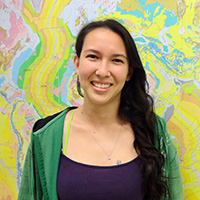 Comparative morphometrics of the diminutive Oligocene oreodont Sespia californica and the larger Sespia ultima from Southern CaliforniaShelby Matsuoka Thursday, May 8th, 2014 |
||
|
||
| ABSTRACT The San Diego Natural History Museum has identified two species of oreodonts (Artiodactyla: Merycoidodontoidea) from the upper Oligocene (28-30 Ma) Otay Formation in San Diego County, California, Sespia californica and the larger Sespia ultima. Preliminary examination of the specimens indicate that S. ultima is larger than S. californica. This was the primary basis for their initial identification. The species were separated by collecting locality, with no evidence of S. ultima found at sites where S. californica specimens were collected and vice versa. Morphometric data were gathered from the post-canine teeth in the upper and lower jaws of each species by measuring the length of post-canine tooth groups (i.e., m1-m3, P1-P4), as well as the width of the third molar in the upper jaw. Because there were many more specimens of S. californica available (N= 259) than S. ultima (N=10), the Kruskal-Wallis test was used, which is a non-parametric test for analyzing unequal populations. When compared by ranking, the morphometric data shows that the size difference observed between the two populations is significant and confirms that they are separate species. Comparing the data to previously published works, the sampled specimens fall within the expected size ranges of their respective species and confirms their identities as S. californica and S. ultima. Strong correlation has been found between the P1-P4 and M1-M2 measurements, which has implications for the paleoecology of Sespia. Although size differences could also be explained by sexual dimorphism and/or ontogenetic variation, there is no morphologic evidence of these factors displayed in the post-canine teeth of either species. |

